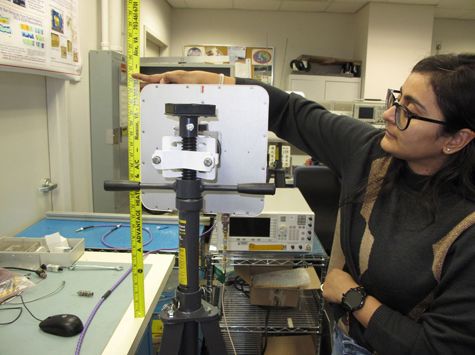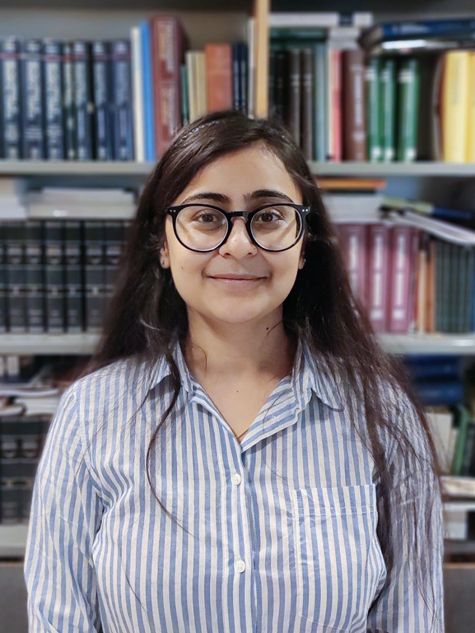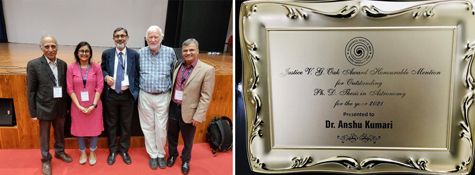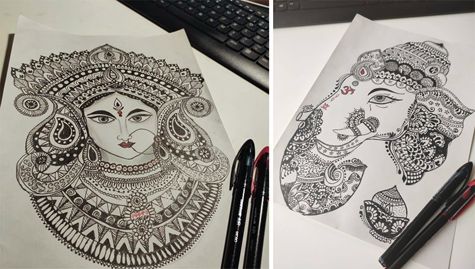Early Career Scientist Spotlight
Dr. Anshu Kumari (she/her/hers)
Radio-Instrument Scientist
Solar Physics Laboratory (671)
What inspired you to pursue a career in radio instrumentation and solar physics?
During my childhood, one particular book that captivated me was Wings of Fire, the autobiography of the late Dr. A. P. J. Abdul Kalam, an eminent aerospace scientist and former Indian president. This book sparked my fascination with the stars and ignited a deep passion within me. Inspired by Dr. Kalam's remarkable story, I made a resolute decision at the tender age of twelve—I was determined to become a scientist. Years later, after completing my engineering degree in Electronics and Communications, I had the privilege of joining the Indian Institute of Astrophysics (IIA) in Bangalore to pursue an Integrated M.Tech-PhD course in astronomical instrumentation.
At IIA, I found the perfect opportunity to blend my engineering knowledge with my passion for astronomy. During my M.Tech program, I was presented with a range of project proposals for my Master's thesis. One proposal, in particular, caught my attention—it involved designing a ground-based radio instrument to study solar eruptions. Eager to explore this field, I embarked on a journey into radio instrumentation and solar radiophysics at the Gauribidanur Radio observatory of IIA, a remote location blessed with awe-inspiring sunsets.
How did you end up working at NASA Goddard?
Prior to joining NASA Goddard, I had the privilege of working with the space physics group at the University of Helsinki, where my focus was on numerical simulations of solar eruptions. This field was completely new to me, but I was eager to dive in and expand my knowledge. While I enjoyed my time in Helsinki, the longing to return to my roots in instrumentation grew more intense later with time.
It was during this time that I had the opportunity to connect with Dr. Nat Gopalswamy, who offered me the chance to develop a proposal for the NASA Postdoctoral Program (NPP). The proposed work would focus on the proof-of-concept study of the Faraday Effect Tracker of Coronal and Heliospheric Structures (FETCH), onboard a next-generation multi-spacecraft comprehensive mission concept. Without hesitation, I seized this opportunity.
Working towards my NPP proposal goals, I am able to fully utilize my expertise and skills. In the antenna laboratory, I design and develop antenna systems and back-end equipment. I also engage in numerical simulations to better understand the behavior of the FETCH system in the space environment. Additionally, I use solar radio observations from novel radio telescopes and remote sensing data.

Credit: Liz Jensen
What is your research focus?
The study of the coronal magnetic field is crucial for understanding the formation, evolution, and dynamics of structures in the solar corona. However, directly measuring magnetic fields in the chromosphere and corona remains a significant challenge in solar physics. In this context, radio techniques offer a practical and effective means of observing solar, heliospheric, and ionospheric space weather phenomena, making them valuable tools for studying the magnetic field in the solar atmosphere.
My research focuses on the implementation and improvement of various radio techniques for investigating and exploring eruptive solar events. By utilizing these techniques, I aim to gain insights into the formation, evolution, and space weather impacts of such events. To achieve this, I actively contribute to the development of ground and space-based state-of-the-art new-generation radio instruments and data analysis pipelines for solar observations.
In addition to utilizing radio techniques and building advanced instruments, I also employ novel data-driven numerical simulations to further enhance our understanding of the formation of flux ropes in the solar corona. Through data-dependent numerical simulations, I simulate the behavior of the solar corona and investigate the mechanisms that lead to the formation of flux ropes. These simulations take into account observational data and incorporate physical models to accurately reproduce the complex dynamics of the solar atmosphere.
Credit: Anshu Kumari
Tell us about one project of yours that has been particularly impactful in your field.
Throughout my PhD journey, I had the incredible opportunity to develop a low-frequency wide-band ground-based solar radio spectro-polarimeter at the Gauribidanur Radio Observatory of the IIA. Over the past seven years, this instrument has been operational and is helping in advancing our understanding of the Sun's magnetic fields. Designed with an antenna front-end that captures radio waves emitted by the Sun, a signal channel for electromagnetic wave transmission, and a high spectral and temporal capable digital receiver for onboard processing and data recording, this instrument provides a gateway to indirect measurements of the Sun's magnetic fields. Its unique capabilities, combined with radio imaging instruments, empower it to function as a Coronal Magnetometer, improving our ability to study and comprehend the magnetic properties of the Sun.
The culmination of my PhD research was centered on this innovative instrument and the compelling new findings it unveiled. As a testament to its significance, my thesis has received remarkable recognition within the Astronomical Society of India (ASI). Notably, it was honored with the prestigious Young Scientist Award in URSI-RCRS, along with the Justice Oak Outstanding Thesis Award (honorable mention) and the K. D. Abhyankar Best Presentation of Thesis.
Credit: Zubair Sheikh (left), Saurabh Singh (right)
Who inspires you?
I draw inspiration from my family. I come from a family of professors from three generations. My elder sister has been a constant source of inspiration, excelling in everything she has pursued, and serving as my first role model. Additionally, my partner, a material science scientist leading his own lab and research group, continues to inspire me with his dedication and achievements. Moreover, my friends provide unwavering support, lifting me up during moments when I feel demotivated. And I am grateful for my students who possess a strong drive to challenge themselves and constantly push their limits in order to achieve new milestones. Their dedication and commitment inspire me. The diverse experiences, collaborations, and research environments have broadened my horizons and enriched my perspective. Each chapter of my research journey has been filled with challenges, growth, and moments of pure inspiration.
Credit: Debesh Bhattacharjee (left), Tom Bridgman (right)
What do you like to do in your free time?
I find solace in being at home, where I can immerse myself in reading, drawing, and experimenting with Indian cuisine. Teaching brings me great fulfillment, as I mentor a group of Indian undergraduate students in the fundamentals of solar physics on a biweekly basis. When I venture outdoors, I indulge my curiosity by exploring the enriching exhibits of the nearby Smithsonian museums. As a creative outlet, I channel my thoughts and humor into crafting comic strips and relatable memes.
I am proud to be a co-founder of INDUS (Indian Network for Dynamic and Unified Solar physicists), a community of passionate young Indian solar physicists spread across the globe. Our mission at INDUS is to foster collaboration, provide guidance to aspiring PhD researchers, and drive collective growth in the field. Currently, I am dedicating my free time to nurturing this group and we are excitedly preparing for the launch of our website.
Credit: Ashutosh Singh
What is a fun fact about you?
During my extensive five year stay at the Gauribidanur Observatory, I found an outlet for sharing my knowledge and experiences on Quora, a popular question-answer platform. Through my answers on astronomy, astrophysics, and personal anecdotes, I managed to amass a following of over a hundred thousand individuals. It brings me joy to encounter students at various institutes across India who recognize me from my Quora contributions. It is particularly fulfilling when they express gratitude for the guidance my answers provided in shaping their career paths.
Additionally, I have a passion for sports and have excelled as a state-level athlete and national-level volleyball player during my school and college days.
Biography
Home Town:
Raxaul, Bihar, India
Undergraduate Degree:
Bachelor of Technology (B.Tech) in Electronics and Communication, Rajasthan Technical University, India
Post-graduate Degrees:
Integrated Master of Technology (M.Tech) and Ph.D in Astronomical Instrumentation, Indian Institute of Astrophysics - University of Calcutta, India





